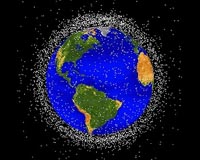 |
Bethesda MD (SPX) Oct 15, 2010 For the past 50+ years space-faring nations of the world have been trashing the near-Earth space without regard to future effects on our environment. Almost every satellite launched into Earth orbit has resulted in multiple objects that have become RSOs (resident space objects), otherwise known as space debris. During the first 40 or so years of accumulating this debris, it was little more than a passing thought and at most an irritant, certainly not seriously considered as a future threat to space commerce and applications. In 2007, China tested an anti-satellite weapon on one of its own expired weather satellites in a polar orbit at an altitude of 865 km. The test was reported to be a success and the resulting debris immediately increased the number of tracked RSOs by 25%. In 2009, and expired Russian Cosmos spacecraft and an active Iridium satellite collided at an altitude of roughly 800 km, and the result was several hundred new RSOs. Current estimates place the total number of trackable RSOs at about 22,500 with most of these in an altitude band of approximately 700 km to 1200 km. In addition, there are thought to be millions of debris objects that are too small to track. While it is true that operational spacecraft in this altitude band are at risk of colliding with debris, space is still "big" and collision probabilities are still low. However, the continued growth of debris appears unstoppable. It took just over 50 years before the first satellite-to-satellite encounter took place. The next one will surely occur in much less than that time. Concern regarding space debris is definitely moving from irritant to concern to a call for action. For several reasons, action is unlikely to occur anytime soon. The technology for removing RSOs does not exist. Although there are many suggestions, none are practical at this time. The economics of debris removal are simply overwhelming. Culturing and political issues may prove to be the most difficult to overcome. It seems entirely possible that access to space may be denied at some point in the future. All developed nations already heavily depend on space to provide vast economic advantages that did not exist just 30 years ago. A loss of space applications could set the world back several decades in terms of communications, weather forecasting, scientific exploration, precision navigation and Earth observations. Is there any good news? One could say that space debris is a growth industry, but there seems to be no customers who will pay for cleaning it up. The big question at the moment is: What are the long-term effects of space debris on access to space and on the Earth's environment. These topics will be discussed in Launchspace's new course addition: Space Debris and the Future of Space Flight in the spring of 2011.
Share This Article With Planet Earth
Related Links Launchspace Space Technology News - Applications and Research
 Sorting The Space Trash
Sorting The Space TrashSydney, Australia (SPX) Sep 24, 2010 We all sort our rubbish by category, allowing recycling to take place. It's easy to understand why. Different items require different processes for disposal. For years, we have been growing increasingly aware of the trash problem in low Earth orbit. Debris from whole satellites to tiny flecks of paint poses a hazard to anything we launch. It can damage spacecraft or even claim lives. With ... read more |
|
| The content herein, unless otherwise known to be public domain, are Copyright 1995-2010 - SpaceDaily. AFP and UPI Wire Stories are copyright Agence France-Presse and United Press International. ESA Portal Reports are copyright European Space Agency. All NASA sourced material is public domain. Additional copyrights may apply in whole or part to other bona fide parties. Advertising does not imply endorsement,agreement or approval of any opinions, statements or information provided by SpaceDaily on any Web page published or hosted by SpaceDaily. Privacy Statement |